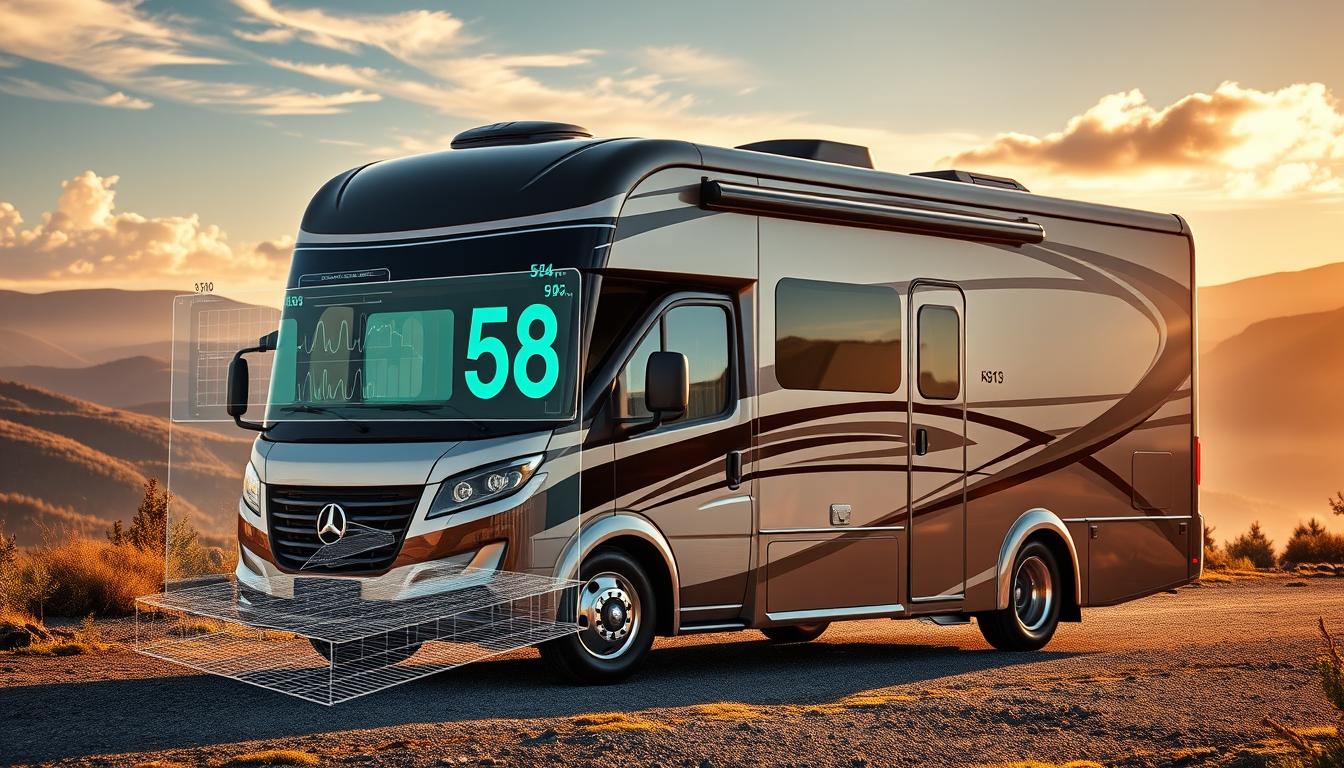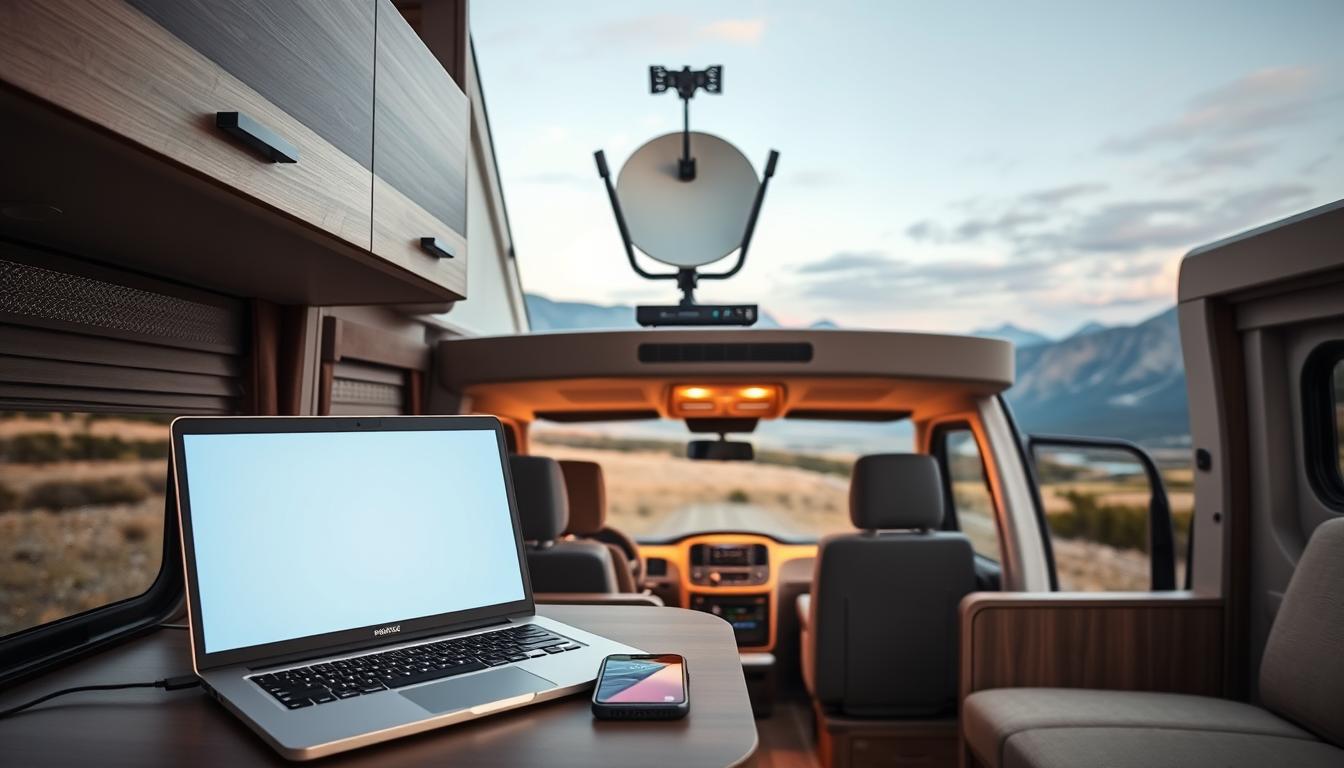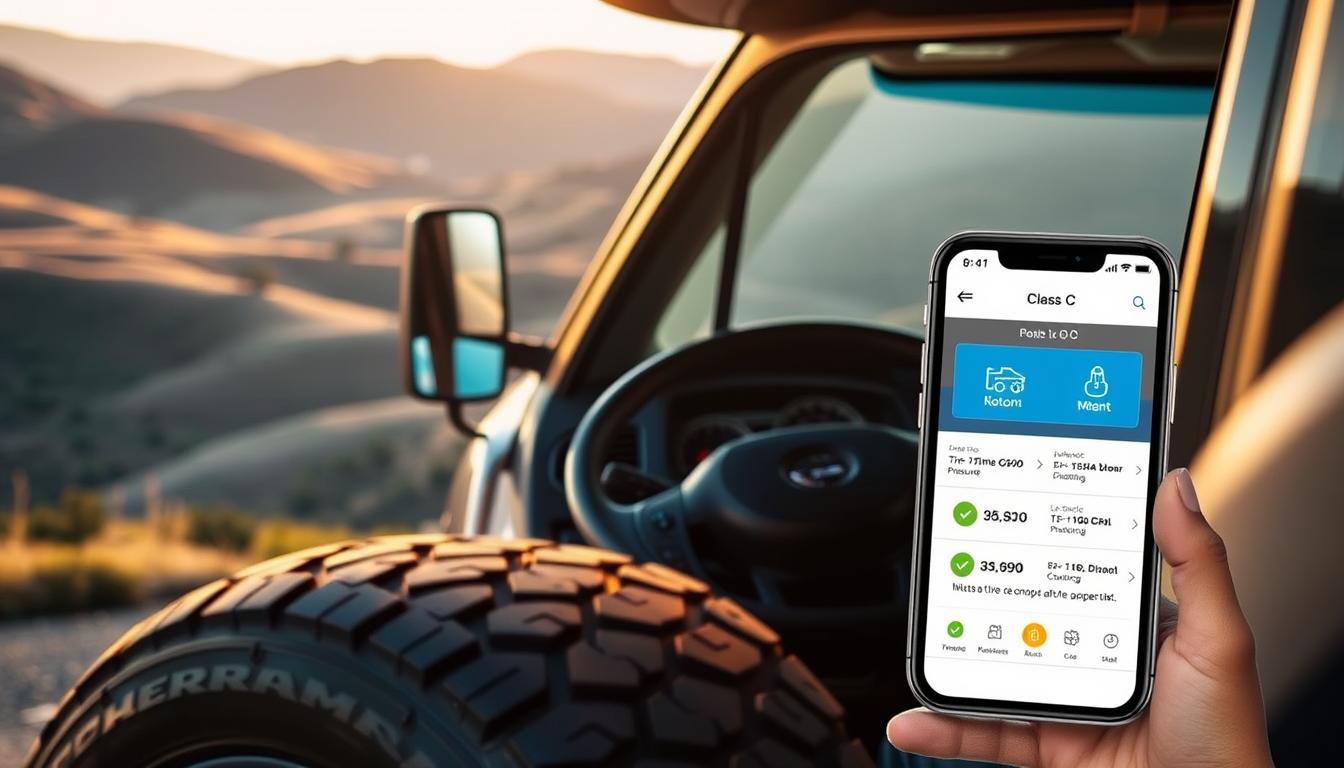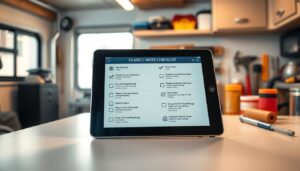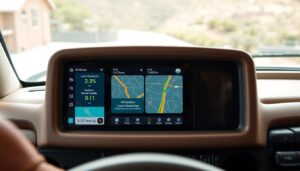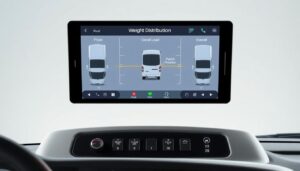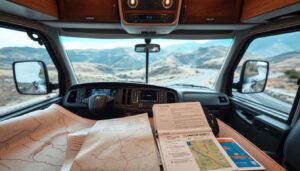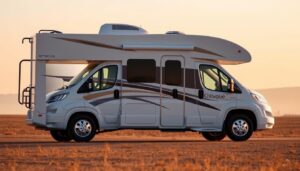Accurate fuel consumption prediction with digital tools for Class C motorhomes
Ever thought about saving fuel on your next trip in a Class C motorhome? Today’s digital tools make accurate fuel consumption prediction possible. Knowing how to manage fuel in these vehicles can change your travel game. It ensures you get the most from every gallon.
By using modern tech for fuel management, you can measure fuel use more accurately. This makes your trips not just fun but also cost-effective.
Understanding Fuel Consumption in Class C Motorhomes
Fuel consumption in Class C motorhomes depends on engine type and vehicle weight. Knowing these factors helps improve motorhome efficiency on trips. Most Class C motorhomes have gasoline or diesel engines, each affecting fuel use differently.
Gasoline engines run at higher revs but might have less torque than diesel engines. Diesel engines, however, are often more fuel-efficient but heavier. This affects the vehicle’s weight and efficiency. Managing these factors helps owners estimate fuel needs for trips.
The total weight of the motorhome also impacts fuel consumption. A heavier motorhome uses more fuel to accelerate. So, owners should only carry what’s necessary.
Understanding engine types, weight, and their impact on fuel consumption is key. This knowledge helps motorhome fans plan better for fuel and travel. It makes their trips more enjoyable and efficient.

The Importance of Accurate Fuel Predictions
Accurate fuel predictions are key to better travel in Class C motorhomes. They help RV owners plan trips without unexpected fuel costs. This planning avoids budget disruptions and helps manage resources better.
Reliable fuel predictions lead to big savings. RV owners can pick the cheapest routes and refuel at the best times. They can also drive more efficiently, making trips smoother.
Good fuel predictions also promote eco-friendly driving. Knowing how much fuel is used helps make better choices. This leads to more efficient travel and a better experience. As technology gets better, so do fuel prediction methods, helping RV owners plan better.
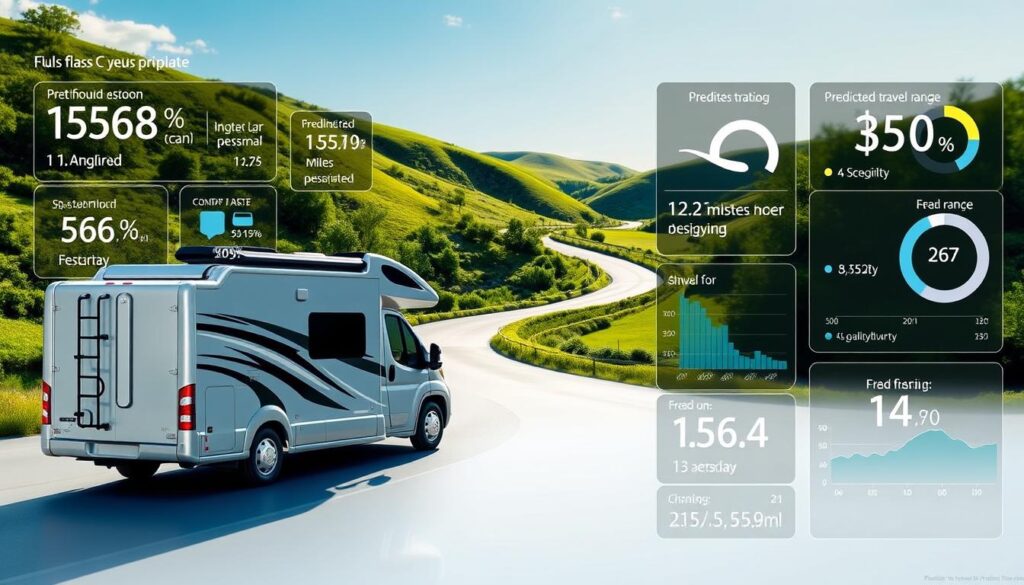
| Factors | Impact on Fuel Predictions |
|---|---|
| Driving Speed | Affects fuel consumption directly; higher speeds lead to increased fuel use. |
| Weight of the RV | Heavier RVs consume more fuel; proper weight management can lead to better predictions. |
| Route Selection | Choosing routes with fewer stops and smoother conditions contributes to cost savings. |
| Engine Maintenance | Well-maintained engines yield better fuel efficiency, enhancing prediction accuracy. |
Common Variables Affecting Fuel Economy
Fuel economy variables are key to a motorhome’s efficiency. Knowing these can help owners improve their motorhome’s performance. Important factors include tire pressure, air temperature, vehicle weight, and driving habits.
Tire pressure greatly affects fuel use. Under-inflated tires increase drag, using more fuel. Keeping tires at the right pressure can save money and improve efficiency.
Air temperature also matters. Cold temperatures can make engines use more fuel. But, warmer temperatures can make engines burn fuel more efficiently.
Vehicle weight also affects fuel use. A heavier motorhome uses more fuel to move. Carrying less weight can improve performance and save fuel.
Driving habits are crucial too. Smooth driving and steady speeds save fuel. Aggressive driving, like quick starts and stops, uses more fuel. Knowing these tips can help owners save money and enjoy their trips more.
Driving Conditions That Impact Fuel Efficiency
Driving conditions greatly affect how much fuel a Class C motorhome uses. The terrain and weather can change how well a vehicle performs. For example, going up hills uses more fuel because it takes more energy.
Driving in cities, with lots of stops and starts, also uses more fuel than driving on highways. Traffic jams and delays waste fuel and lower your mileage. Bad weather, like heavy rain or strong winds, makes driving harder and less fuel-efficient.
Knowing about these driving conditions helps motorhome owners. By changing how they drive and understanding the environment, they can use less fuel. This makes their trips more affordable.
Using Technology to Track Fuel Consumption
In recent years, technology tracking has become key for Class C motorhome owners. Tools and apps give real-time data to help RV owners save fuel. These digital tools are essential for better fuel management.
Modern motorhomes have onboard computers that show exact fuel use. They look at speed, engine, and load to give insights. Mobile apps also track fuel use, making it easier to see how much you’re using.
GPS technology helps track fuel use over long distances. It shows how efficient your driving is in real-time. This helps you change your driving to use less fuel.
A comparison of popular tools shows their benefits:
| Tool Name | Features | Benefits |
|---|---|---|
| Fuelio | Logs fuel usage, costs, and provides graphs | User-friendly interface and extensive reports |
| GasBuddy | Finds nearby gas stations and tracks prices | Cost-saving features and community reviews |
| Car Minder | Records fuel consumption and maintenance history | Holistic management of vehicle expenses |
Using technology to track fuel use helps motorhome owners save money. It also promotes driving in a way that’s good for the environment.
Tools for Predicting Fuel Consumption in Class C Motorhomes
Knowing how much fuel your Class C motorhome will use is key. There are advanced tools to help you guess fuel use. These tools include digital dashboards and GPS tracking, each with its own benefits.
Digital Dashboards and Fuel Monitors
Digital dashboards in modern motorhomes show fuel use in real-time. They give you info like mileage, speed, and fuel levels. This lets you see how your driving affects fuel use.
By using this info, you can change your driving or route to save fuel. Brands like Thor Motor Coach and Winnebago include these features in their motorhomes.
GPS-Based Mileage Tracking Tools
GPS tools are also great for tracking how far you’ve gone. Knowing the exact distance helps figure out fuel use. Different driving conditions can change how much fuel you use.
These GPS tracking tools give you exact distance traveled. This helps you see how fuel use changes over time. Using these tools can help you plan fuel use for both short and long trips. You can find more about these tools and how to use them at this resource.
How Weather Influences Fuel Consumption
Weather conditions greatly affect fuel use in RV travels. Changes in temperature, wind, and humidity impact Class C motorhomes’ efficiency. For example, hot weather makes engines work harder, raising fuel use.
Wind is also key. Driving against strong winds increases fuel use. RV owners should plan routes and schedules with wind in mind. Knowing the weather forecast helps save fuel costs.
Humidity also plays a role in fuel efficiency. High humidity can change air density and engine performance. By watching weather, travelers can prepare for its effects on fuel economy.
Weight Management for Better Fuel Efficiency
Managing weight is key for better fuel use in Class C motorhomes. Too much weight hurts both speed and distance, making fuel costs go up. Every extra pound puts more stress on the engine, which can shorten its life.
To improve how much you can carry, RV owners should check their vehicle’s weight often. This helps find and get rid of things you don’t need. Cleaning out your RV can help it run better and use less fuel.
Smart storage is another way to control weight. Using light storage and making the most of space helps keep the load balanced. This boosts fuel efficiency and keeps your RV within safe weight limits.
| Item | Weight (lbs) | Example |
|---|---|---|
| Water | 8.34 | 1 gallon |
| Propane Tank | 30 | Estimated full tank |
| Camping Gear | 50 | Tents, tools, etc. |
| Food Supplies | 40 | Canned goods and perishables |
| Clothing | 20 | For a week-long trip |
Knowing how much all these items weigh is important for better fuel use. By carefully choosing what to pack, RV fans can enjoy their trips more and save money on gas.
Aerodynamic Factors Impacting Fuel Economy
Aerodynamic design is key to a Class C motorhome’s fuel economy. The shape of a vehicle affects how it moves through the air. This, in turn, impacts fuel use. A well-designed vehicle can cut down on wind resistance, saving fuel costs over time.
Things like the vehicle’s shape and where accessories are placed matter a lot. For example, a motorhome with a sleek front moves better through the air than a boxy one. Also, securing items in the back helps avoid air turbulence.
Here are some key aerodynamic factors that contribute to improved fuel economy:
- Smooth vehicle contours to minimize resistance.
- Placement of roof racks and other accessories to reduce drag.
- Weight distribution within the vehicle to support a balanced airflow.
By making changes to improve aerodynamics, owners can see big savings in fuel. Knowing and using these tips helps make Class C motorhomes more fuel-efficient.
How Tire Pressure Affects Fuel Consumption
Keeping the right tire pressure is key for better fuel efficiency in Class C motorhomes. Tires that are not the right pressure use more fuel. Under-inflated tires make the engine work harder, which means more fuel is used.
Over-inflated tires can also cause issues. They might use less fuel but can affect traction and wear unevenly. This can make driving less safe and less fuel-efficient. Checking and adjusting tire pressure regularly helps keep fuel economy up and safety on the road.
Motorhome owners should check tire pressure monthly and before long trips. Keeping tire pressure at the manufacturer’s recommended level helps save fuel and extends tire life.
Utilizing Fuel Flow Meters for Precision Measurement
Fuel flow meters are a modern way to measure fuel use in Class C motorhomes. They give real-time data to improve fuel usage tracking. These devices measure the fuel volume flowing through the engine, offering deep insights into fuel consumption.
Installing fuel flow meters is easy and can be done by experts or DIY enthusiasts. Most models fit well in existing fuel systems, working with many motorhome types.
Using fuel flow meters boosts the accuracy of tracking fuel use. It helps manage fuel economy better. By spotting fuel usage differences, owners can adjust driving or maintenance. This leads to big savings and less wasted fuel, showing the value of precise measurement for efficient RV use.
Driving Behavior and Its Impact on Fuel Economy
RV drivers often don’t realize how their driving affects fuel economy. By driving more efficiently, they can save a lot of fuel.
One key thing is to control your acceleration. Quick starts use more fuel and can damage your vehicle. Driving at a steady speed helps fuel flow better, making your RV more efficient.
Also, following speed limits is important. Driving fast uses more fuel to keep moving. This hurts your fuel economy.
Other habits like smooth braking and gradual acceleration help a lot. Planning your route and using cruise control on highways can also save fuel.
Trip Planning and Fuel Consumption Optimization
Planning your trip well is key to saving fuel and making your travel more efficient. By choosing the right routes, you can use less fuel and avoid traffic jams. Highways are usually better for fuel than city streets.
Adding rest stops to your plan can also help with fuel. Picking good spots for breaks makes refueling easy and keeps drivers alert. Use apps for traffic updates to avoid delays and save fuel.
When planning your trip, think about your vehicle’s fuel economy. Knowing how it performs helps you make better choices about your route. Good planning means better fuel use and a more enjoyable trip.
Maintenance Tips for Improved Fuel Efficiency
Keeping your Class C motorhome in good shape is key to better fuel use. Simple tasks like oil changes help a lot. They keep the engine running well, which means you use less fuel.
Don’t forget about air filters. A clean one helps the engine breathe better, making it more fuel-efficient. Check it every few months, especially if you drive in dusty areas.
Tire care is also important. Tires that are the right pressure and in good shape help you save fuel. Make sure to check them often.
Here’s a simple checklist to keep your Class C motorhome running smoothly:
| Maintenance Task | Frequency |
|---|---|
| Oil Change | Every 3,000 to 5,000 miles |
| Air Filter Replacement | Every 12,000 to 15,000 miles |
| Tire Inspection | Monthly |
| Brake System Check | Every 10,000 miles |
| Battery Maintenance | Every six months |
By sticking to these maintenance tips, you can make your RV more fuel-efficient. Regular care not only saves fuel but also makes your motorhome last longer.
Real-Life Examples of Fuel Consumption Tracking
Many Class C motorhome owners have shared valuable insights. They track their fuel consumption to make better decisions. Each family uses different methods to monitor their fuel use.
One family traveled the East Coast and used a mobile app. It helped them track mileage and fuel purchases. They found it useful for saving money on their trip.
Another family used a notebook to log their fuel and distances. They were happy with the results, finding routes that saved fuel. They were able to adjust their trip based on their findings.
These examples show that tracking fuel can improve efficiency. Parents said teaching their kids about fuel conservation made the trip fun and educational.
Future Trends in Fuel Consumption Technology
The world of fuel consumption technology is changing fast. New advancements are making Class C motorhomes more efficient. We’re seeing a big move towards using artificial intelligence and machine learning. These tools help predict fuel use based on how you drive and the conditions you’re in.
Smart devices with advanced sensors are key in tracking fuel use. They give real-time feedback and predictive analytics. This lets users change their driving habits to save fuel. As RVs get these technologies, owners will see big improvements in their trips.
Blockchain technology is also on the rise. It could make fuel consumption tracking safer and more open. This means we might trust fuel efficiency data more. The growth of vehicle connectivity will also boost these advancements.
It’s important for makers and tech companies to work together. They need to create systems that talk to each other smoothly. This teamwork will make fuel-saving tech better, leading to a greener future for RV travel.
Conclusion
Technology and driving habits are key to better fuel use in Class C motorhomes. Digital tools help RV owners track their fuel use. This leads to smarter choices that improve travel.
Using the tips from this article, motorhome fans can make their trips better. Keeping tires right and planning trips well save fuel and money. This means more fun and less worry about fuel costs.
Adopting these modern ways saves money and makes trips better. As tech gets better, so will fuel use prediction. This makes every trip more fun and efficient.
FAQ
What factors contribute to fuel consumption in Class C motorhomes?
Fuel consumption is affected by many things. Engine type, vehicle weight, and design shape are key. Tire pressure, driving habits, and weather also play a role.
How can I accurately predict my fuel needs for a trip in my motorhome?
To predict fuel needs, track your motorhome’s fuel use. Consider weight and driving habits. Also, plan your route wisely.
What role does tire pressure play in fuel efficiency?
Proper tire pressure is vital for fuel efficiency. Under- or over-inflation increases resistance, raising fuel use. Regular checks are crucial.
Are there any recommended apps or tools for tracking fuel consumption?
Yes, many apps and onboard computers track fuel use. They log mileage and provide real-time data. This helps RV owners save fuel.
How does weight management affect fuel efficiency in Class C motorhomes?
Extra weight hurts acceleration and fuel mileage. To improve, declutter and use storage wisely. This reduces weight and boosts efficiency.
How do driving conditions influence fuel consumption?
Driving conditions like terrain and weather affect fuel use. Hilly routes or bad weather increase fuel use. Plan routes to avoid these.
What maintenance tips can improve fuel efficiency in my motorhome?
Regular maintenance is key. Change oil, replace air filters, and check tires. This prevents drops in performance and boosts efficiency.
What aerodynamics considerations should I keep in mind for better fuel economy?
Aerodynamics is crucial for fuel economy. Vehicle shape and wind resistance matter. Proper loading and design can reduce drag and improve efficiency.
How do weather conditions affect fuel consumption?
Weather greatly affects fuel use. Temperature, wind, and humidity change consumption rates. Be aware of weather to plan trips better.
What are fuel flow meters, and how do they help in measuring consumption?
Fuel flow meters track fuel use in real-time. They measure fuel intake, offering accurate economy assessments. This helps owners make better choices.
